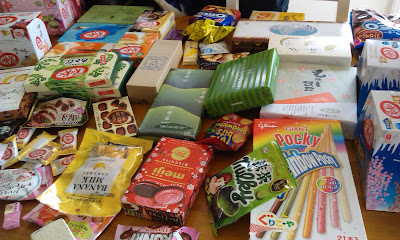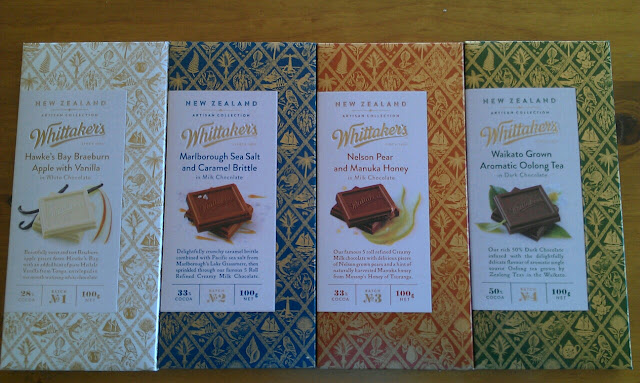Kyoto: Arashiyama, Nijo Castle, Fushimi Inari, Okonomiyaki
Day Five
BREAKFAST
Aware that we had limited options, we decided to go to the McDonald's we'd spotted the night before - unfortunately, this wasn't open, so we opted for a DeliFrance bakery next door. Guess what? No photos. (I know, I'm a failure.)ARASHIYAMA
From Kyoto station we took a train to Sanarashiyama station. After studying a map and help from a station attendant we located the Bamboo Grove, which is indescribably beautiful.
 |
| Bamboo Grove. The colour seems a little washed out but the whole country seems to have a filter that makes everything seem older and more mature |
After wandering around (and getting lost) in the Bamboo Grove we circled the area. There are many rickshaws driven by both men and women available for use. There are a lot of small shops in the area also good for souvenirs, of the edible and non-edible kind.
 |
| Artsy photo of a rickshaw, courtesy of Dad. |
 |
| Arashiyama and its surrounding area |
In Arashiyama station is also the Kimono Garden
 |
| Kimono Garden: rows of fabric that makes one think of the traditional Japanese garment |
LUNCH : NEIGHBOURHOOD RESTAURANT
Though I can't describe much about it, it was directly to the left once you exit Arashiyama station. The restaurants vary from cheap to pricy very quickly side by side, and offers mostly Japanese-style food.
 |
| Beef bento, ¥900 |
 |
| Oyako-don (chicken and egg bowl), about ¥600 from memory |
 |
| Beef udon, around ¥600 |
 |
| Hamburger steak, about ¥750 |
NIJO-CASTLE
Nijo-jo, or Nijo Castle, is about ten minutes' walk from Nijo station, but as the area of the castle is so large and the entrances few, we had to talk about another ten minutes to reach the entrance. General admission is ¥600 per adult.
 |
| Some of the castle premises from above |
Photography inside the castle is not allowed, but outdoors is permitted. If there's ever time to visit Nijo Castle I highly recommend it. Walking inside the castle was an experience - while we had initially thought hidden overhead speakers played tweeting of birds to add life (it was cold, and felt a bit dead), but in isolated rooms the sound stopped until we realised that it was the creaking of the old wooden floorboards - unlike ugly moans at home, these creaks were faint, delicate, and melodic, much like someone humming in an adjacent room or a particularly loud bird chirping outside - I'm not sure if this is advertised as one of the features of the castle, but it should be.
 |
| Outside Nijo Castle main entrance |
 |
| The gate between Nijo Castle's main building entrance and the gardens |
The gardens and pond behind the castle are equally beautiful.
 |
| The castle gardens... I would have loved to be there in spring, when the cherry blossoms bloom |
 |
| Part of the gardens |
 |
| Normally uncovered, these branches are protected using bamboo shades over winter against the colder conditions |
A lot of the castle's history focuses on the artwork created when the castle was inhabited - there's a separate exhibition for this, but as we still wanted to visit other places we decided to forego it.
FUSHIMI-INARI
Fushimi-Inari is a shrine whose entrance is directly opposite Inari station, making it very easy to access. Visible by the red gate at the entrance, there are a few small shops surrounding which sells trinkets and food, as expected in many tourist areas. I would hardly suggest eating there - having tried a couple of the stands, my travel partners agreed it was sub-par and over-priced. Let's just say I never thought takoyaki couldn't be delicious.
 |
| Takoyaki, ¥500 for 7 |
 |
| The entrance from outside the station |
 |
| The entrance further in |
Fushimi-Inari is a row of red gates situated at the base of and along Inari Mountain, with rumours that suggest a dead body is buried within each torii (red gate), fuelling the eeriness of the place, especially as we visited when it was beginning to grow dark, and a little chillier. Already not a fan of creepy stories, I was not reassured when Sis#2 reminded me of the creativity (and often morbidity) of Japanese folklore.
 |
| The torii at the beginning |
The initial torii were larger than expected, and spaced quite far apart. As it continued up the hill, it split into two pathways, where the torii were smaller and much closer together, making be feel slightly claustrophobic. As it's suggested in travel websites, and by friends and family who have previously visited the shrine, the torii decrease in density as you progress up the mountain. Taking roughly two hours to scale the full mountain, there are few sights at the very top, and only a few torii, so we stopped about a third of the way up.
 |
| Parts of the village in the surrounding area at the bottom of the mountain |
DINNER : OKONOMIYAKI MACHI-YA
We returned to Porta dining for the second night, having passed by an okonomiyaki restaurant that caught our eye the night before. Called [お好み焼き 町や] (Okonomiyaki Machi-ya, translating roughly to Okononomiyaki Town Shop), the focus is on the Japanese-style pancake cooked in front of you on a hotplate. Unfortunately for us, the place was relatively full, so we had a table separate from the main grill at the counter, and had okonomiyaki, cooked elsewhere, delivered to our hotplate for us.
 |
| The hotaplate, greased and ready for action |
Condiments such as mayonnaise and famous okonomiyaki sauce came in extra bottles on the table, allowing us to serve the okonomiyaki, and garnish as our palates desired.
 |
| Tonpeiyaki (a cheat's okonomiyaki which is more of an omelette as it doesn't use batter). |
 |
| One of the okonomiyaki specials, basic okonomiyaki, modan-yaki ("modern" okonomiyaki). After slathering in sauce and mayonnaise, they generally tasted the same. |
End Day 5






Comments
Post a Comment